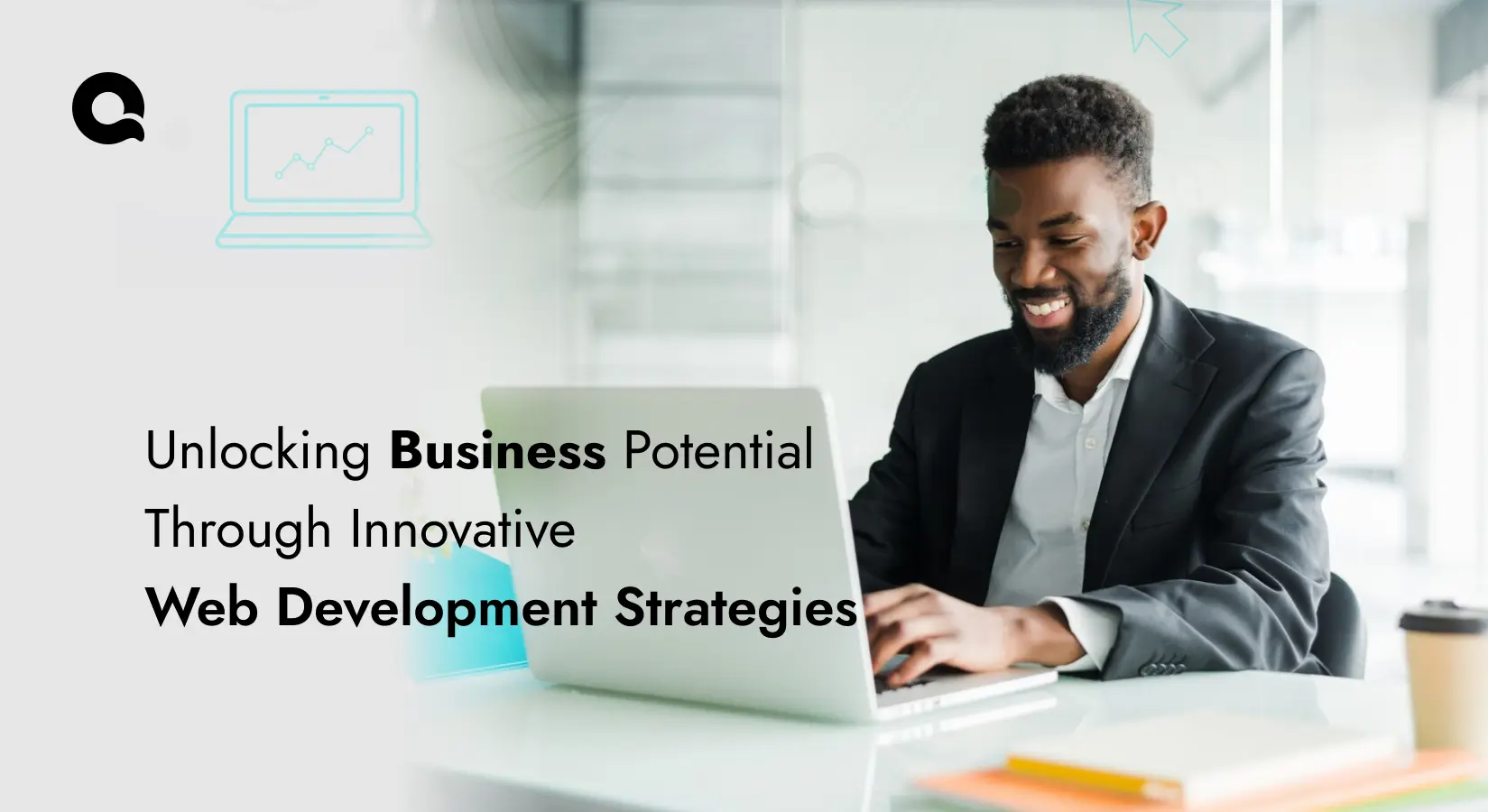
In the digital age, web development is far more than creating functional websites; it’s about leveraging innovative strategies that unlock the full potential of a business. From creating captivating user experiences to enhancing brand visibility, the right web development approach can set your business apart and fuel growth. In this blog, we’ll dive into some of the most effective web development strategies and explore how they help unlock business potential.
1. Emphasize User-Centered Design (UCD) for Enhanced Engagement
- Overview: User-centered design (UCD) is a strategy focused on understanding and meeting the needs of your target audience. Websites designed with UCD principles prioritize user satisfaction, which can significantly improve engagement and conversion rates.
- How It Helps: By designing with users in mind, businesses can reduce bounce rates and retain more visitors. Positive user experiences lead to repeat visits and increased customer loyalty.
- Example: E-commerce platforms like Amazon and Etsy use user-centered design, offering intuitive navigation, personalized recommendations, and streamlined checkout processes. These features simplify the shopping experience, resulting in higher customer satisfaction and sales.
2. Utilize Progressive Web Applications (PWAs) for Better Accessibility
- Overview: Progressive Web Applications (PWAs) combine the best aspects of web and mobile apps, providing a reliable and fast experience even with poor internet connectivity. PWAs are responsive, fast, and can work offline, making them accessible on any device.
- How It Helps: PWAs expand your business reach by catering to a broader audience, including users in areas with unreliable internet. They improve user experience, boost engagement, and lower development costs compared to native apps.
- Example: Pinterest saw a 60% increase in user engagement and a 40% reduction in loading times after implementing its PWA. The app’s offline capabilities and optimized performance make it a preferred choice for users worldwide.
3. Leverage Search Engine Optimization (SEO) for Better Visibility
- Overview: SEO is essential for any business looking to attract organic traffic and improve search engine rankings. Integrating SEO from the beginning of web development ensures that your site is optimized for search engines and discoverable by potential customers.
- How It Helps: A website optimized for SEO ranks higher on search engine results pages (SERPs), driving more organic traffic and potential leads to your business. This visibility is crucial for brand awareness and growth.
- Example: Airbnb has consistently optimized its site for search engines, resulting in higher SERP rankings and substantial organic traffic. The company uses well-structured URLs, relevant keywords, and a responsive design, all contributing to better SEO.
4. Implement Responsive and Mobile-First Design for a Seamless Experience
- Overview: Mobile-first design prioritizes mobile devices, ensuring that users have a consistent and optimized experience across all devices. Since more than half of global web traffic is from mobile devices, a mobile-friendly website is essential for reaching a wider audience.
- How It Helps: A responsive and mobile-first design enhances user experience, reduces bounce rates, and boosts SEO. It ensures that users on all devices, including tablets and smartphones, have a seamless experience on your site.
- Example: Zara has a responsive and mobile-first design that simplifies navigation and offers a smooth shopping experience on any device. This approach helps capture mobile shoppers, a critical demographic for online retail.
5. Focus on Speed Optimization for Improved User Experience and SEO
- Overview: Page load time is a crucial factor in both user experience and SEO. Slow-loading websites leads to higher bounce rates, while faster sites retain users and rank better on search engines.
- How It Helps: Speed optimization leads to better user engagement, higher SEO rankings, and improved conversions. Compressing images, enabling caching, and reducing server response times are a few effective techniques for speed optimization.
- Example: Walmart achieved a 2% increase in conversions for every one-second improvement in page load time. This statistic underscores the impact of speed optimization on a business’s bottom line.
6. Incorporate Artificial Intelligence (AI) for Personalized Experiences
- Overview: AI can significantly enhance user experience by personalizing content, providing product recommendations, and streamlining customer support through chatbots.
- How It Helps: AI-driven personalization can increase engagement, improve conversions, and help build strong customer relationships. It also allows businesses to understand user preferences and behavior more accurately.
- Example: Netflix uses AI algorithms to analyze user viewing patterns and suggest content tailored to individual preferences. This personalization enhances user satisfaction and encourages extended app usage.
7. Adopt Content Management Systems (CMS) for Flexible Content Control
- Overview: A Content Management System (CMS) allows businesses to manage and update website content without requiring technical knowledge. Popular CMS platforms like WordPress, Drupal, and Joomla make it easy for businesses to keep their content fresh and relevant.
- How It Helps: CMSs offer flexibility, cost-efficiency, and quick updates. This flexibility is particularly beneficial for blogs, news sites, and businesses that frequently update content.
- Example: BBC uses a CMS to manage and update its vast content library, ensuring it remains current and easy to navigate for users.
8. Prioritize Security Measures for Customer Trust and Compliance
- Overview: Security is a top priority in web development, especially with increasing cyber threats. Implementing secure protocols, such as SSL certificates and multi-factor authentication, protects user data and builds trust.
- How It Helps: Security features enhance customer trust and help businesses comply with legal regulations, such as GDPR. These measures also prevent data breaches that could harm a company’s reputation.
- Example: PayPal incorporates stringent security measures, including end-to-end encryption and biometric verification, ensuring that users feel secure during online transactions.
9. Incorporate Analytics Tools for Data-Driven Decisions
- Overview: Analytics tools like Google Analytics and Hotjar provide valuable insights into user behavior, helping businesses make data-driven decisions. These insights can guide website improvements and marketing strategies.
- How It Helps: By understanding how users interact with your site, you can optimize content, improve user experience, and increase conversions. Analytics tools also allow for measuring the effectiveness of marketing campaigns.
- Example: Spotify uses analytics to understand user listening patterns, allowing it to provide personalized recommendations and targeted marketing that drive user engagement.
10. Utilize Cloud Computing for Enhanced Performance and Scalability
- Overview: Cloud-based solutions offer reliable performance and scalability for businesses. Hosting websites and applications on cloud platforms like AWS, Google Cloud, or Azure ensures they can handle traffic spikes without compromising performance.
- How It Helps: Cloud computing enables businesses to scale quickly, manage resources efficiently, and reduce downtime. It’s also cost-effective, making it suitable for businesses of all sizes.
- Example: Dropbox uses cloud computing to offer seamless file storage and sharing services, ensuring reliable performance regardless of user location.
Conclusion
In a world where digital interactions are at the forefront of business success, web development plays a pivotal role in driving growth. By implementing innovative strategies—such as user-centered design, SEO-focused development, and AI-driven personalization—businesses can create websites that not only meet user expectations but also enhance brand credibility and drive conversions. Each of these strategies offers distinct benefits, from expanding reach with PWAs to ensuring scalability with cloud computing.
Investing in advanced web development isn’t just about building a website; it’s about crafting a dynamic digital presence that evolves with your business. To explore how these strategies can empower your business, contact QalbIT for customized solutions that unlock your business potential.
Frequently asked questions
User-centered design focuses on meeting users' needs, which enhances engagement, reduces bounce rates, and builds customer loyalty. This approach is vital for retaining customers and creating a positive online experience.
SEO increases a website’s visibility on search engines, driving organic traffic and attracting potential customers. This boost in visibility is essential for brand awareness, which ultimately contributes to growth and customer acquisition.
AI in web development offers personalized experiences, predictive analytics, and efficient customer support through chatbots. These features improve engagement, simplify navigation, and build stronger customer relationships.
With over half of internet traffic from mobile devices, mobile-first design ensures a seamless and optimized experience for mobile users. It reduces bounce rates, enhances engagement, and improves a site’s SEO ranking.






